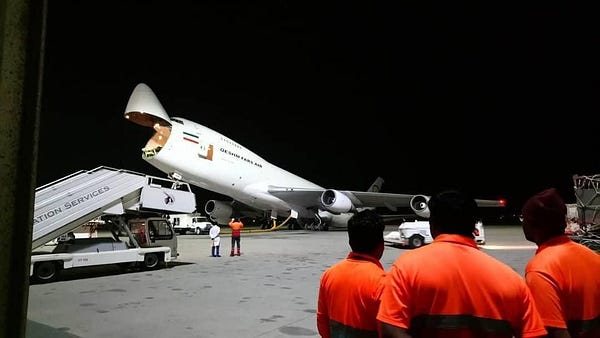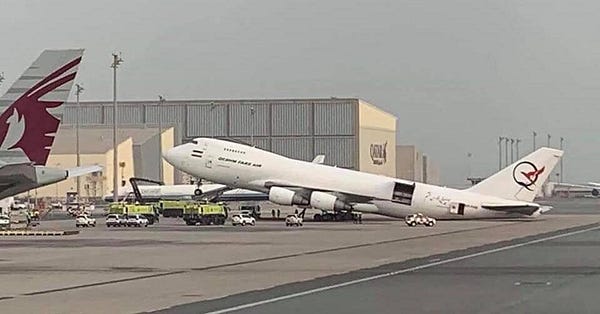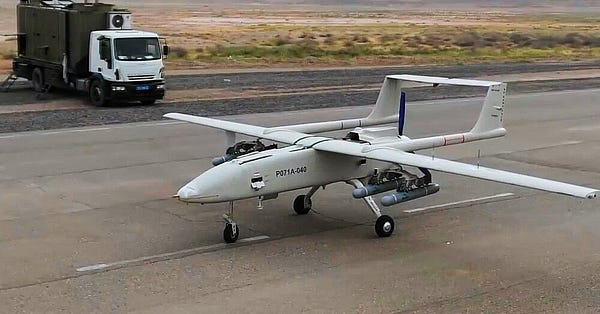The Iran–Ethiopia airlift: Pouya Air and Qeshm Fars Air
Over the past six months, I have frequently written about cargo aircraft from Turkey and especially the United Arab Emirates visiting Ethiopia’s largest and international airport, Addis Ababa Bole Airport, and the main base of the Ethiopian Air Force, Harar Meda Military Airport, which is located near the city of Bishoftu. Besides flights from these countries, aircraft from a third country have been flying to Ethiopia: Iran. In this article, I will provide some background information about the two airlines involved, “Qeshm Fars Air” and “Pouya Air”, and will provide an overview of the flights that have taken place.
Qeshm Fars Air
Qeshm Fars Air (also called Fars Air Qeshm) is an Iranian airline mainly known for their flights from Iran’s capital Tehran to Damascus, Syria and airports in Venezuela.





Historical Venezuela flights by Qeshm Fars have been linked to delivery of Mohajer-6 UAVs, a UAV type currently also used in Ethiopia:
Some examples of Qeshm Fars Air operations around Syria:




Both of their 747-200s (EP-FAA and EP-FAB) are around 30 years old at this point, and are part of a small group of 747-200 aircraft remaining in active service worldwide. Other 747-200 operators include Moldova’s Fly Pro reg. ER-BAT, Georgia’s Geo-Sky (4L-GEN and 4L-GEO), the Islamic Republic of Iran Air Force (IRIAF) and the United States Air Force (USAF) presidential Boeings VC-25A, based on the 747-200.
In a famous incident in 2019, a Qeshm Fars Air 747-200 (EP-FAB) tipped over in Doha, Qatar, a result of improper unloading strategies.




Back in 2019, the U.S. Department of Treasury’s Office of Foreign Assets Control (OFAC) took action against Qeshm Fars Air and both of their aircraft “under Executive Order (E.O.) 13224, a counter-terrorism authority”. They state that Qeshm Fars Air and its fleet of two B747 aircraft “operated regular cargo flights to Damascus, delivering cargo, including weapons shipments, on behalf of the IRGC-QF [Iran Revolutionary Guard Corps – Quds Force]”. They add:
“OFAC is also identifying two B747 aircraft as property in which Qeshm Fars Air has an interest: EP-FAA and EP-FAB. These identifications serve to warn those who provide support to these aircraft that they could be exposed to U.S. sanctions.”
Pouya Air
Although Pouya Air’s website lists two aircraft, only one Pouya Air aircraft (Ilyushin Il-76 reg. EP-PUS) is known to be currently active. In broken English, their website states:
“Pouyaair is a established company , which has highly experienced Crew; expert crews under employment ; they are courteous in presenting their assigned service in the field of heavy load air transportation this company self-possesses , two unit of spacious body cargo A/C within the fleet , ready to give various services all over the world , live animals , bulky cargos , variety of general cargos , including D.G Material transportation have been , reputedly conducted by this company , with maximum customer satisfaction.”
Because of MLAT tracking, less is known about their route network, but it is known that also Pouya Air’s EP-PUS regularly visited destinations in Syria. Planespotting databases can be used to determine that regular destinations of EP-PUS also include Beijing and Moscow.


Like Qeshm Fars Air, also Pouya Air is listed on OFAC’s Sanctions List. A press release, dated 24 May 2018, states:
“The facilitators designated by the Treasury today have been procuring parts and providing services for the fleets of sanctioned Iranian airlines, including (…) Pouya Air. In so doing, they extend a lifeline to the IRGC-QF and enable the Iranian regime to transport weapons, fighters, and money to its proxies, including Hizballah, and to prop up the brutal Assad regime (…)”
“Additionally, we are identifying a number of aircraft associated with designated Iranian airlines (…) Pouya Air, giving notice to those who grant landing rights and provide general services to these aircraft that they could be exposed to U.S. sanctions.
The aviation community is also alerted to the sanctions risk for those maintaining commercial relationships with Mahan Air and other designated Iranian airlines, including (…) Pouya Air.”
The flights
Routes and frequency
A total of fourteen flights by Iranian aircraft to Ethiopia are known to have taken place over the period August 2021 – December 2021. These include six flights by Pouya Air’s EP-PUS, five flights by Qeshm Fars Air’s EP-FAA and two flights by Qeshm Fars Air’s EP-FAB. One remaining flight was done by an unidentified Iranian aircraft using ICAO code 730000.
In a previous blog, I explained the differences between full ADS-B tracking and positionless Mode-S tracking. This issue also exists for Iranian flights to Ethiopia. Qeshm Fars Air aircraft sometimes do and sometimes do not use full ADS-B. Pouya Air’s Il-76 never use full ADS-B. The same analysis techniques introduced in this previous blog have also been used for Iranian aircraft.
In one peculiar event, a Qeshm Fars Air 747-200 had landed at Addis Ababa Bole Airport unseen on most tracking websites, because she was not using full ADS-B. When starting up at Addis Ababa Bole Airport, however, ADS-B was briefly turned on, making the aircraft visible to the outside world. ADS-B was turned back off minutes later, so only part of the taxi run towards the start of the runway is included in the ADS-B track.



As I reported previously, Fly Sky Airlines flights visited both Addis Ababa Bole Airport and Harar Meda Military Airport, oftentimes both on the same day. In contrast, Iranian airlines seem to focus on one airport alone.
Qeshm Fars Air, operating two Boeing 747-200 cargo aircraft, only flies to Addis Ababa Bole Airport. Ilyushin Il-76 operator Pouya Air on the other hand flies to Harar Meda Military Airport. This difference might be related to a lack of services or facilities available at Harar Meda Military Airport, which might be essential for a 747-200, but not for an Il-76, or to weight and/or size limitations at Harar Meda Military Airport.
Visual evidence
In order to confirm my Mode-S investigation results, it is desirable to find independent visual confirmation using satellite images or images taken on ground. Some of this evidence is presented below.
Pouya Air’s EP-PUS was seen on ground at Harar Meda Airport on Sentinel-2 imagery on 16 Aug 2021 (note that the Il-76 silhouette on the 11 Aug 2021 image was added manually, for reference purposes).
Pictures of EP-PUS around Harar Meda Military Airport have been provided to me by someone in the vicinity of the airport, but cannot yet be published yet, over security concerns. Hopefully I will still be able to publish these images at a later point.



Because Qeshm Fars Air aircraft visit Addis Ababa Bole Airport, located within the large and densely populated capital city, more pictures exist of the aircraft on ground at and flying over Addis Ababa. For example, a Qeshm Fars Air visit to Addis Ababa on 17 Aug 2021 was spotted by a local.


The latest visit, Qeshm Fars Air flight 9966 from Tehran to Addis Ababa on 26 Dec 2021, has even better documentation. For one, the inbound flight was visible on full ADS-B. Furthermore, various people on ground provided me with images of the aircraft on ground at Bole Airport and in the skies over Addis Ababa.







After almost 120 flights, it seems like the airlift between the UAE and Ethiopia has now come to a halt, perhaps over foreign pressure. At this point in time however, there seems to be a slight increase in Iran-Ethiopia flight frequency. Needless to say, I will keep monitoring the situation closely, and will make the outside world aware of any future flights, both on this blog and on Twitter.







